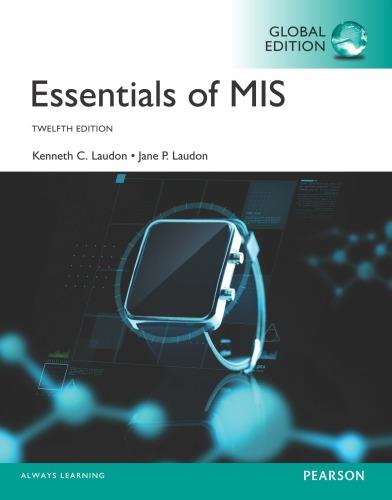Question
3. Consider an economy with two agents (agents a and b), two goods - labor/leisure and a consumption good - and two firms. Both firms
3. Consider an economy with two agents (agents a and b), two goods - labor/leisure and a consumption good - and two firms. Both firms transform labor into the consumption good. Firm 1,
with production function y1 = f(L1), belongs to agent a, and firm 2, with production function
y2 = g(L2), belongs to agent b. (L denotes a quantity of labor and y a quantity of consumption
good produced). Each agent has 3 units of time which can be used as leisure or sold as labor.
Firm 2 uses a technique of production which creates a negative externality z, a chemical which has
an adverse effect on the consumers and whose quantity is proportional to the level of production:
z = y2. The utility and production functions are as follows
ui(`i
, xi
, z) = p
`ixi
1
8
z, i = a, b, f(L1) = L1, g(L2) = 2p
L2
where ` denotes leisure and x the quantity of consumption good.
(a) Derive the competitive equilibrium of this economy, i.e. equilibrium prices, production and
consumption plans. [Restrict attention to allocations where both firms produce a positive
amount.]
(b) To show that the equilibrium is not Pareto optimal consider the following marginal change
from the equilibrium allocation: add /2 of leisure to each agent and decrease the labor
used by firm 2 by . Decrease equally the consumption of the consumption good of the two
agents. Do not change anything to firm 1's plan. Compute the marginal change in utility for
each agent and show that both agents are better off. Explain. [It may be easier to keep the
partial derivative notation for estimating the change in utilities and then evaluate the values of these
derivatives at the equilibrium.]
(c) Assume that the government fixes a limit z
on the amount of pollution emitted by firm 2.
Solve for the 'regulated competitive equilibrium' as a function of z
. [Assume that z
is
smaller than the value found in (a)].
(d) To find the optimal z
come back to your calculations in (b) and find the value of z
such
that the change considered in that question (or the reverse when < 0) cannot improve the
utilities of the agents.
(a) State and explain four economic influences on an individual firm's demand for labour. (25)
(b) Explain, with the aid of a labour market diagram in each case, how equilibrium wage rates are
determined in:
A free labour market;
A labour market where a trade union has negotiated a minimum wage. (25)
(c) Women in Ireland earn on average 17.1% less per hour than men, according to a study by the
European Commission (Tackling the gender pay gap in the European Union, 2011).
(i) Outline two possible reasons for the lower wage rates earned by women in the Irish
economy.
(ii) Outline one measure that could be taken to close the gender pay gap. (15)
(d) Explain briefly Karl Marx's economic theory about the exploitation of labour in a capitalist
system.
Step by Step Solution
There are 3 Steps involved in it
Step: 1

Get Instant Access to Expert-Tailored Solutions
See step-by-step solutions with expert insights and AI powered tools for academic success
Step: 2

Step: 3

Ace Your Homework with AI
Get the answers you need in no time with our AI-driven, step-by-step assistance
Get Started


